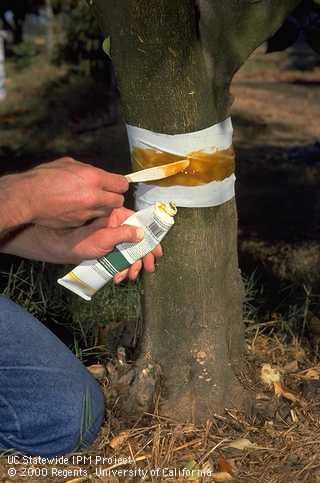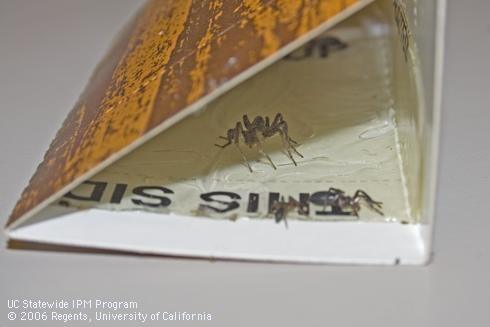![An assortment of traps and barriers are available at retail nursery and garden centers. [Photo by K. Windbiel-Rojas] An assortment of traps and barriers are available at retail nursery and garden centers. [Photo by K. Windbiel-Rojas]](http://ucanr.edu/blogs/UCIPMurbanpests/blogfiles/23376.jpg)
[From October 2013 issue of the Retail Nursery and Garden Center IPM News.]
Traps and physical barriers can be excellent tools for detecting, catching, or preventing pest invasions. Most retail nurseries and garden centers carry a variety of these types of tools, often displayed together with other products to help customers implement a multi-pronged IPM program to most effectively manage their pests.
Traps
Traps may be used to monitor or detect a pest population, to catch and identify the pest, to reduce local pest density, or more than one of these functions. Commercial traps are available for controlling or detecting various moth species (pheromone traps), whiteflies and thrips (sticky traps), flies and yellowjackets, snails and slugs, bed bugs, spiders, cockroaches and many other pests.
Pheromone traps use attractants produced by an organism to affect the behavior of other members of the same species. These traps usually have a sticky surface or chamber for catching the pests. Pheromone traps are often most useful in monitoring the presence, location, or activity of pests but may not actually reduce pest numbers, so it's critical to use the traps along with cultural, biological and chemical control methods as needed. Common pheromone traps include those for codling moth, clothes moths, pantry moths, and german cockroaches.
Many sticky traps, such as those for whiteflies, thrips, spiders, cockroaches, or fungus gnats, don't use a lure or chemical pheromone to attract the pest, but instead intercept crawling or flying pests in areas they travel. Other traps that use a food or a chemical lure to attract flies or yellowjackets can help reduce these nuisance pests around the yard. Commercially available snail and slug traps can be baited using beer or a water/sugar/yeast mixture.
Depending on the pest, you may need to place several traps around the home or landscape to determine the pest's location or level of infestation. Traps should be checked frequently and changed if necessary.
Barriers and Screens
Sometimes the best way to prevent pest damage is to keep the pests away with physical barriers. Caulking up cracks in homes and structures or installing door sweeps can exclude spiders, ants, and other crawling insects from getting inside. Keep ants out of trees and shrubs by applying sticky barriers such as Tanglefoot to the trunks. Install copper barriers to keep snails and slugs from reaching plants in raised beds or from climbing up trees.
Place row covers, hot caps, and other types of plant cages over young plants to keep pests out. Covers can be removed after the sensitive seedling stage or left on for added protection from insects and birds.
Ask your home improvement store for assistance in finding items to help repair or replace openings and holes in window and door screens. Properly maintained screens help keep an array of flying or crawling pests such as ants, flies, mosquitoes, spiders, and rodents out of the house.
Use as part of IPM
It's important to use these tools in conjunction with other methods such as cleaning up attractive food sources (rotten fruit, pet food spills, garbage); removing clutter, weedy areas, and other hiding places that may harbor pests; hand-picking or hosing off pests; properly irrigating, fertilizing, and pruning plants; and if needed, applying a pesticide that targets that pest but doesn't harm people, pets, beneficial organisms, or the environment
For information about specific pests and how traps and barriers are effective in managing them, visit the UC IPM Website at www.ipm.ucanr.edu.
Modified from “Using Traps and Barriers for Insects and Other Pests” from the Retail Nursery and Garden Center IPM Newsletter, Vol. 3, No. 3, October 2013.
Author - Associate Director for Urban & Community IPM/ Area Urban IPM Advisor
Attached Images:

